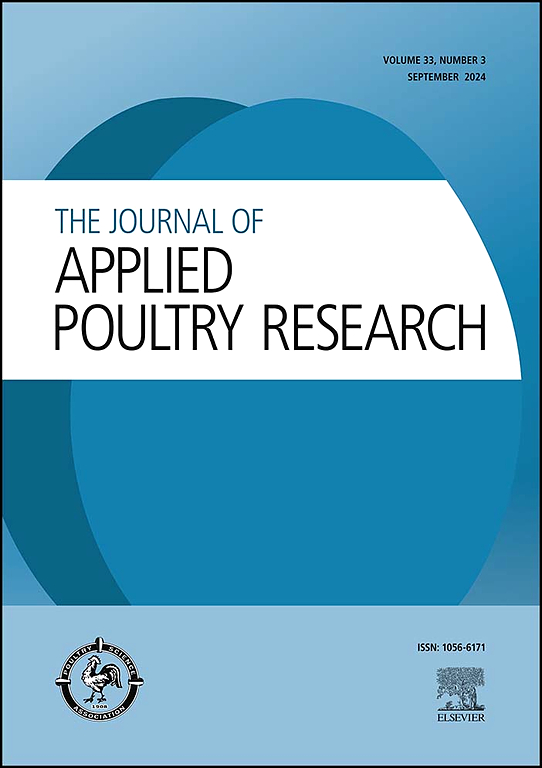Dietary copper and L-arginine: influence on pullet maturation and productivity
IF 2
3区 农林科学
Q2 AGRICULTURE, DAIRY & ANIMAL SCIENCE
引用次数: 0
Abstract
In this study, different levels of copper and L-arginine (LA) were used in diets for pullets. The effects of these supplements were examined on sexual maturation parameters, blood biochemical profiles, immune system, and antibodies titer against Influenza A (H9N2-subtype), Newcastle (B1 Type), and infectious bronchitis virus (IBV) H120 vaccine strain during the rearing phase of pullets. A total of 360 Hy-Line W-80 white layer-type pullets (13-week-old) were used in two test periods: the first period (developer) from the age of 13-15 weeks, and the second period (pre-layer) from the age of 16-17 weeks. The pullets were assigned to a 2 × 3 factorial arrangement with two levels of supplemental Cu (15 and 30 mg/kg in the developer diet, denoted as Cu15, Cu30) and three levels of LA. These include the recommended level according to Hy-line (RHL), as well as 20% higher (LA20) and 40% higher (LA40) than the recommended level in the diet. The experiment was design a randomized complete block with 6 treatments. Each treatment had 6 replicates, with 10 birds per pen. The total duration of the experiment lasted for 6 weeks. Dietary inclusion of Cu15+LA40, Cu30+RHL, and as well as the use of diet supplemented with Cu30+LA20 increased shank length compared to the group fed Cu15+RHL in developer period (P<0.05). In pre-layer period, the birds fed with Cu15+LA40 diet had greater comb height than both Cu15+LA20 and Cu30+LA40 groups (P<0.05). Furthermore, birds fed with Cu30+LA20 diet exhibited lower levels of LDL and LDL/HDL ratio than those fed on the Cu15+RHL diet (P<0.05). Heterophile to lymphocyte ratio (HET/LYM) decreased in the birds fed with Cu15+LA40 and Cu30+LA20 compared to the Cu15+RHL treatment (P<0.05). Estradiol hormone increased in the blood serum of birds fed diets containing Cu30+LA20, compared to the Cu15+LA20 and Cu15+RHL diets (P<0.05). Based on the results, adding copper 15 and 30 mg copper/kg and L-arginine 40% higher than the recommended level to the growing phase diets of pullets have positive effects on performance parameters, blood biochemical profiles, and immune system. Also, physiological maturity indices improve within specific age ranges.
饲粮铜和l -精氨酸对小鸡成熟和产出率的影响
本试验在雏鸡饲粮中添加不同水平的铜和l -精氨酸(LA)。在雏鸡饲养阶段,研究了这些补充剂对性成熟参数、血液生化特征、免疫系统和抗甲型流感(h9n2亚型)、新城流感(B1型)和传染性支气管炎病毒(IBV) H120疫苗株的抗体滴度的影响。选用海兰W-80白蛋鸡360只(13周龄),分两期进行试验:第一期为13-15周龄(发育期),第二期为16-17周龄(预产蛋期)。试验采用2 × 3因子试验,添加2个水平的Cu(发育日粮中15和30 mg/kg,分别表示为Cu15、Cu30)和3个水平的LA。其中包括根据hyline (RHL)推荐的水平,以及比饮食中的推荐水平高出20% (LA20)和40% (LA40)。试验设计为随机完全区组,共6个处理。每个处理6个重复,每栏10只。试验期6周。发育期饲粮中添加Cu15+LA40、Cu30+RHL以及饲粮中添加Cu30+LA20比添加Cu15+RHL组的小腿长度增加(P<0.05)。蛋前期,Cu15+LA40组鸡冠高度高于Cu15+LA20和Cu30+LA40组(P<0.05)。此外,Cu30+LA20饲粮的LDL水平和LDL/HDL比值低于Cu15+RHL饲粮(P<0.05)。与Cu15+RHL处理相比,Cu15+LA40和Cu30+LA20处理的禽类嗜异性淋巴细胞比(HET/LYM)降低(P<0.05)。与Cu15+LA20和Cu15+RHL饲粮相比,Cu30+LA20饲粮的血清雌二醇水平显著升高(p < 0.05)。综上所述,在育成期饲粮中添加15、30 mg铜/kg和高于推荐水平40%的l -精氨酸对仔鸡生产性能、血液生化指标和免疫系统均有积极影响。在特定年龄范围内,生理成熟度指标也有所提高。
本文章由计算机程序翻译,如有差异,请以英文原文为准。
求助全文
约1分钟内获得全文
求助全文
来源期刊

Journal of Applied Poultry Research
农林科学-奶制品与动物科学
CiteScore
4.10
自引率
10.50%
发文量
80
审稿时长
104 days
期刊介绍:
The Journal of Applied Poultry Research (JAPR) publishes original research reports, field reports, and reviews on breeding, hatching, health and disease, layer management, meat bird processing and products, meat bird management, microbiology, food safety, nutrition, environment, sanitation, welfare, and economics. As of January 2020, JAPR will become an Open Access journal with no subscription charges, meaning authors who publish here can make their research immediately, permanently, and freely accessible worldwide while retaining copyright to their work. Papers submitted for publication after October 1, 2019 will be published as Open Access papers.
The readers of JAPR are in education, extension, industry, and government, including research, teaching, administration, veterinary medicine, management, production, quality assurance, product development, and technical services. Nutritionists, breeder flock supervisors, production managers, microbiologists, laboratory personnel, food safety and sanitation managers, poultry processing managers, feed manufacturers, and egg producers use JAPR to keep up with current applied poultry research.
 求助内容:
求助内容: 应助结果提醒方式:
应助结果提醒方式:


